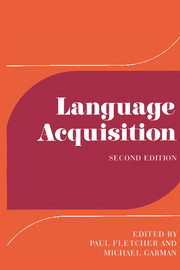Book contents
- Frontmatter
- Contents
- Contributors
- Preface
- Part I Contexts and determinants
- Part II The development of linguistic systems: phonology
- Part III The development of linguistic systems: grammar
- Introduction
- 13 Early vocabulary
- 14 Early syntax
- 15 Assessing morphological development
- 16 Personal pronouns
- 17 Tense and aspect
- 18 Modality
- 19 Deixis
- 20 A crosslinguistic perspective: morphology and syntax
- Part IV Later language development
- Notes to chapters
- Bibliography and citation index
- General index
- Titles in the series
16 - Personal pronouns
Published online by Cambridge University Press: 05 June 2012
- Frontmatter
- Contents
- Contributors
- Preface
- Part I Contexts and determinants
- Part II The development of linguistic systems: phonology
- Part III The development of linguistic systems: grammar
- Introduction
- 13 Early vocabulary
- 14 Early syntax
- 15 Assessing morphological development
- 16 Personal pronouns
- 17 Tense and aspect
- 18 Modality
- 19 Deixis
- 20 A crosslinguistic perspective: morphology and syntax
- Part IV Later language development
- Notes to chapters
- Bibliography and citation index
- General index
- Titles in the series
Summary
Introduction
The acquisition of personal pronouns entails control of a range of pragmatic, semantic, syntactic and morphological distinctions. Every pronominal form represents a convergence of such distinctions. The pronoun-acquiring child must isolate each pronominal form, must establish that there are conditions under which it is appropriate to identify individuals in terms of their speech role, and must match each pronominal form isolated to the specific speech role it designates. The child must also determine the syntactic distribution of the form, and any further semantic features which it entails. This chapter will consider only certain aspects of this complex process. It will explore the route which the child takes to the set of speech role categories encoded by personal pronouns.
I shall start by looking at the semantic and pragmatic properties of pronouns which have been the basis for predictions about pronoun development and which have directed investigations into children's pronouns. I shall then turn to the kinds of evidence used to test these predictions, and the methods used to collect such evidence. The bulk of the chapter will be devoted to reporting and discussing the findings which have emerged from studies of children's pronouns. It will assess the role of the different factors investigated in pronoun development, and the inferences made about the kinds of concepts the child brings to pronoun development, and will yield some surprising conclusions about the complexity of the child's early notions of perspective.
- Type
- Chapter
- Information
- Language AcquisitionStudies in First Language Development, pp. 339 - 355Publisher: Cambridge University PressPrint publication year: 1986
- 30
- Cited by



